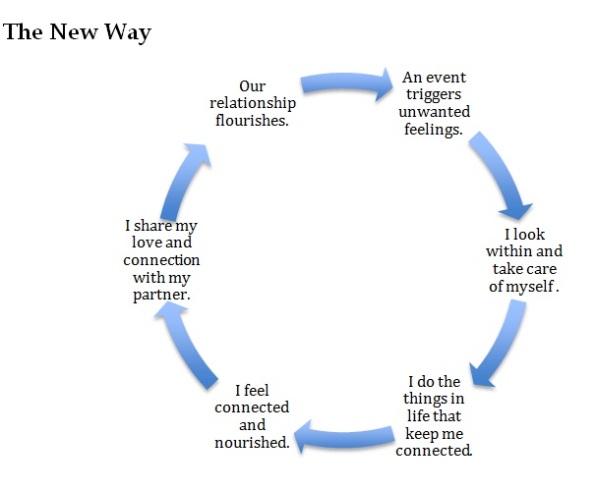After realising that I left my ex-husband for things that I needed to be giving myself, I have learnt a new way to be in a relationship with myself and others. I have much more energy, I am happy within myself and my relationships are blossoming.
We all love to be liked by someone else, don’t we? This is a natural condition of being human. It is flattering, comforting, it is great to have a companion to do things with, it feeds our need for human connection and many more desirable things. But if “liking being liked” is the basis of your relationship, is that really loving our partners? Is it being loving to ourselves?
What is it that we love? The person? Or the fact that the other person takes care of things that we think we don’t have to worry about when we are in a relationship? Things like not feeling lonely, having a companion to do things with, feeling good about ourselves, having an interest, feeling connected, and numerous other things.
What is it that we are missing and not giving ourselves? If we expect our partners to take responsibility for the things that we can be responsible for, is it any wonder we have so much conflict in relationships! We don’t have to think about what we want, or how to make friends with others, or what interests us, as our partner will do all that for us! When we start to do what our partner suggests and it is not what we want, do we accept responsibility for not liking what they suggested? Not likely, more often than not we blame our partner for not getting it right! If we do not know ourselves what we want, what friends we like, what makes us happy, how to resolve our own inner conflicts, how can a husband, wife or partner know how to do this for us?!
More than likely our partner does not know the rules of the game as often these things are unspoken. So, we think our partner will take care of our unwanted emotions, it is just that they do not know that!
Perhaps they go away for work and it does not seem like they are paying attention to our needs, so we start to notice feeling lonely. If we are not taking responsibility for keeping connected to ourselves and others, we are more than likely going to blame our partners for not being there and hence being lonely. They are often shocked as they had no idea that they were supposed to be filling up or fixing up our unwanted emotions. So we come across needy, and guess what, when we are needy often our partners are repelled and either withdraw or “fight” and we do not get what we wanted in the first place. Then we are really on the downward roller coaster.
So, how do we move from creating a worse situation than we started with?
How do we create a flourishing relationship where we both support ourselves and each other?
Perhaps there is another way…
What is different in the New Way?
- Accepting that many things in life trigger unwanted emotions, and often these have nothing to do with the current situation or our partner. It is likely they are from a past memory of an event.
- Letting go of the need to “talk” about our problems immediately and giving ourselves time to communicate with ourselves to understand what is happening and what we can do for ourselves
- Being present to our body sensations and emotions and allowing them to be acknowledged and released through the body.
- Taking responsibility for caring for ourselves on the inside emotionally and spiritually as well as physically, relationally, financially, etc., on the outside.
- Giving up blame and projecting our issues onto others and looking outside ourselves for our solutions.
- Taking actions that nourish ourselves, feeding our souls, body, mind and spirit! Learning what gives us energy.
- Sharing our concerns in a way that communicates that we don’t want to be “fixed” up by anyone else.
- Sharing the love and connection we gain from doing the things that bring us joy with our loved ones.
- Accepting our imperfections, and having tolerance and understanding for ourselves and others.
- Being a supportive partner to each other as we grow into our loving adult selves throughout our lives.
How many relationships have ended as a result of us not taking responsibility for the things that we could have been taking responsibility for? It is a tragedy, but it is a consequence of the transition we have been making from dependent relationships to inter-dependent relationships.
This is a new shift in the way we view relationships and has broader implications for overcoming the power struggles in relationships. We have been making this shift since the days of women’s independence. At first, in the western world, we made structural shifts in the external things such as equality, jobs, voting and legal rights.
I now see the shift in both men and women taking responsibility for their inner life and partnering with each other to share each other’s journeys in life as we grow our loving adult selves. This is a new form of power. When we take on responsibility for our inner life there is the possibility of a new freedom that we may have never even considered.
Please email me what you are doing to create a new loving relationship. I would love to hear your story.
Does this provoke more questions than answers? Email me and I will respond.
Deborah Lange

 Photo credit: andreyutzu
Photo credit: andreyutzu 
